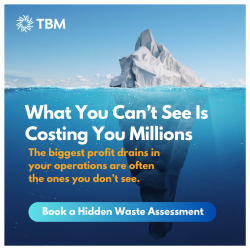Getting big mining projects right is no small feat. Mine construction is incredibly complex, with long lifecycles and enormous amounts of capital at stake.
Research shows that 4 out of 5 megaprojects, particularly mine construction projects, are completed late and run a staggering 43% over budget!
The good news is it doesn’t have to be this way. I recently had the opportunity to discuss how lean concepts and practices can drive profitable growth at the 2022 International Mining and Resources Conference in Australia (IMARC). As a global operations and supply chain consulting firm, TBM helps companies across numerous industries leverage the power of lean tools and operating systems discipline to eliminate waste, improve efficiencies, and create value for the customer. These principles are particularly relevant today as mining companies are feeling the effects of inflation like everyone else. Given that delays and project overruns are so common in mining, costing companies tens to hundreds of millions of dollars in lost revenues and extra expenses, industry leaders are realizing that the key to profitability and success over time lies in stamping out the waste inherent in their processes.
Facing down problematic projects with lean tools
Whether you are a mine operator, construction contractor, or equipment supplier, you are all too aware of how costly missed deadlines and downtime can be to your business and your bottom line. To be successful, mining companies must achieve and maintain high equipment effectiveness and constantly target waste. Operationally, they need to focus on cross-organizational alignment to keep the full team, including senior management, working in tandem to solve problems as they arise. Taken together, these challenges indicate that mining organizations that are not able to manage their capital, resources, and processes efficiently will struggle to compete — and ultimately fail to deliver solid margins and overall results.
That was the situation facing a client who engaged us to assist with a subterranean copper mine construction project in South America. At the time, the company was 9 months behind schedule and incurring hefty fines for not complying with contract terms. Company leaders knew they had to act, and act quickly, to turn things around. A diagnostic assessment revealed a number of issues, including inefficient drilling processes, disorganized movement of equipment between fronts, frequent equipment breakdowns, and poor collaboration and coordination of teams (often resulting in people standing around with nothing to do).
Our work focused on numerous lean tools and processes that involved:
- Plan governance, transparency, and accountability
- Visual management problem solving and leader standard work
- Alignment of all contractor activities
- Identification of improvement priorities
- Development of an implementation plan
As the lean initiatives gained traction, the project went from 9 months behind schedule to on-time opening. The company realized $460 million in cost savings and significantly increased the number of explosions, excavation meters, and tons of extractions. This was a very public project. When it was completed, the client was pleased to share with media outlets that they got the project back on schedule and captured $1 billion in revenue!
Harnessing the power of lean thinking in mining
The copper mine construction project in South America is a powerful example of the results lean principles are designed to deliver. Opportunities to reduce costs and increase revenue are tremendous in the mining industry. Companies can focus on three areas where we see the most opportunity for improvement through the proper understanding and application of lean tools.
- Efficient movement of equipment and materials
Very often in the mining environment, equipment and materials are not in the right place when needed. Our research with clients shows that 80% of delays are due to equipment and materials that are unavailable or in the wrong place. Companies spend considerable time, effort, and money on tools to address this issue. So why is it still a problem?
There are a number of factors, including unreliable equipment maintenance (spare parts not available, excess unplanned maintenance), planning that doesn’t reflect project realities, lack of real time information, and contractors working in silos.
To address these challenges, we focus on three core elements of mine construction: Equipment Location, Rock Movement, and MRO Materials. This is where the concept of Pull Planning comes into play. Pull Planning is a disciplined observation focused on using up-to-date information on what is actually happening instead of what was planned. The information is then dynamically re-sequenced to avoid issues that are causing delays and to increase productivity. The results can have a significant impact. In the case of the subterranean copper mine construction process, the company was able to increase explosions from 3 per day to 19 — more than a six-fold improvement in productivity.
- Equipment maintenance and availability
Everybody has planned maintenance schedules to avoid downtime and repairs. But they do not tend to be dynamic. Usually, they are based on historical data and manufacturer recommendations. Training operators to conduct autonomous maintenance checks before and after each use of the equipment can identify potential problems. Equipment can then be pulled forward in the maintenance schedule to avoid corrective situations and breakdowns — a preemptive strike!
The other component of this process is ensuring spare parts inventory systems are constantly being updated. After one month of utilizing this process, one of our clients increased mine truck availability from 82% to 85%, resulting in 20% more rocks out of the mine every day.
- Cross-organizational alignment
In mining, there are often multiple teams working side by side in the mine under different contracts and incentive plans. This can make collaboration more challenging and lead to one team inadvertently undermining the work of another group.
Plan of the day meetings are common, but often ineffective. Improve them through better commitment, visibility, and accountability. Several lean concepts can be utilized, including:
- Leader standard work discipline (ensuring leader activities are value driven, not just reactive)
- Enforcing attendance
- Making meetings public by involving all stakeholders
- Reviewing prior shift performance
- Identifying countermeasures (training people to be problem solvers)
- Tracking resolution
- Discussing plan for next shift
- Implementing leadership Obeya meetings
Mining your competitive advantage
In such a rapidly changing business environment, the opportunities for mining companies to grow and prosper are immense. However, the path is not without obstacles. Lean principles and tools can be extremely powerful within this landscape to help companies improve processes, increase production, eliminate delays — and best of all — capture billions in revenue.





